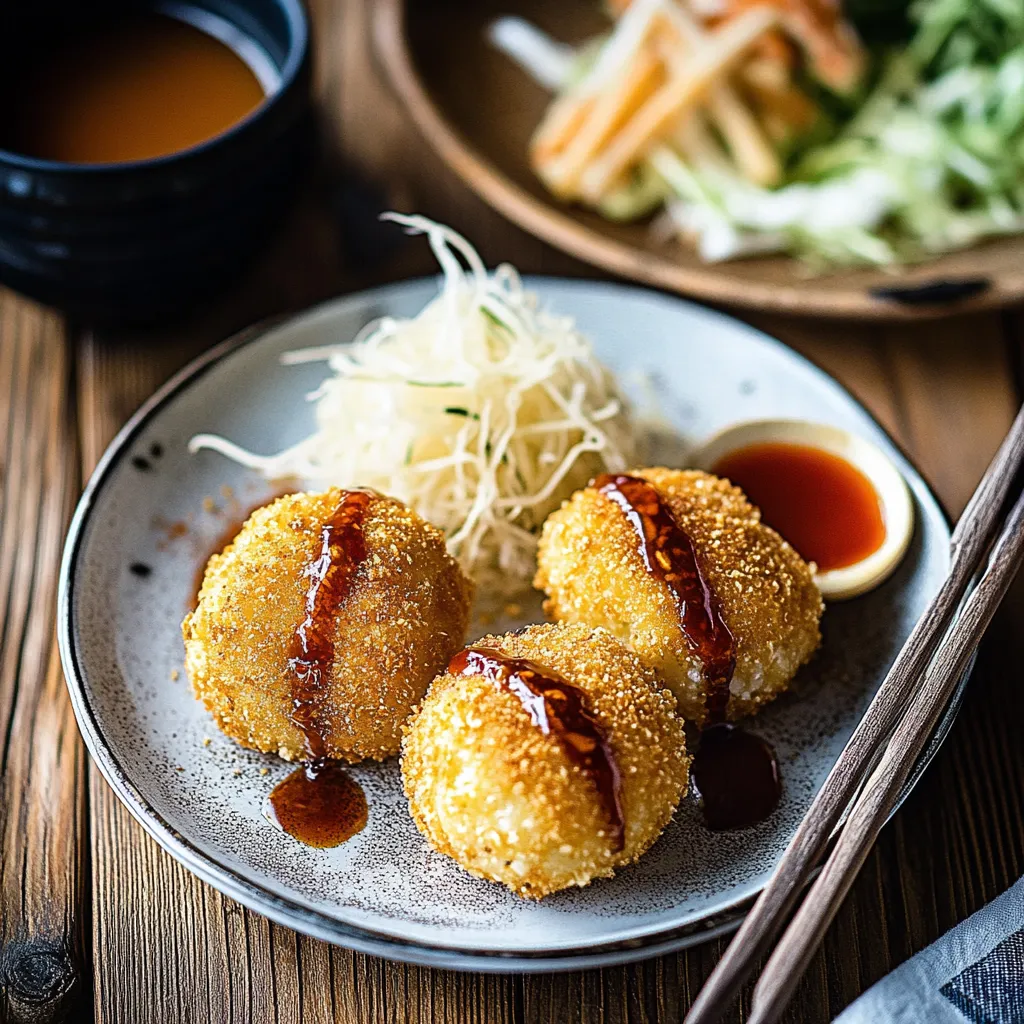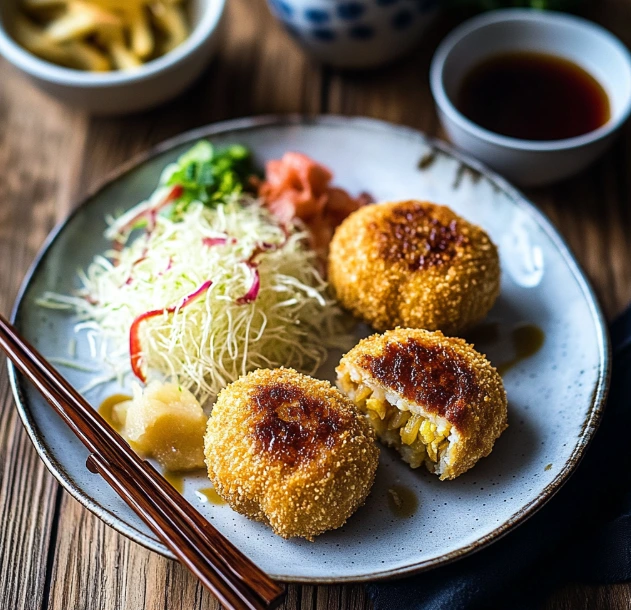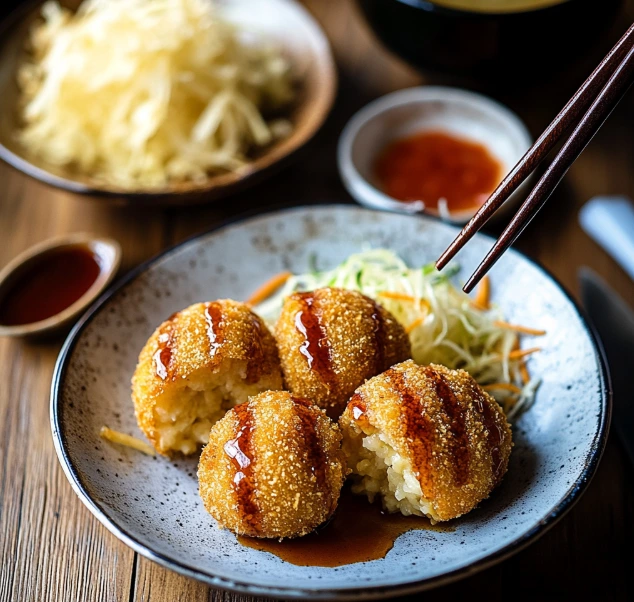 Pin it
Pin it
Korokke represents the heart of Japanese comfort food - where East meets West in perfect harmony. These golden-brown croquettes reveal a soul-warming interior of seasoned potatoes and meat when you break through their crispy panko coating. Each bite delivers the perfect contrast of textures: a satisfying crunch giving way to a creamy, savory center that embodies the essence of Japanese home cooking.
Growing up in Japan, watching my mother shape each korokke with practiced hands taught me more than just cooking - it showed me how love could be expressed through food. Even now, the sound of panko crisping in oil takes me back to those precious moments in her kitchen.
Essential Ingredients Selection
- Russet potatoes: Their high starch content creates the ideal fluffy texture while absorbing the savory meat flavors perfectly
- Premium ground beef: Choose meat with 80/20 fat content to ensure your korokke stays moist and flavorful
- Yellow onions: These release their natural sweetness when properly caramelized, adding depth to every bite
- Japanese panko: Only authentic Japanese brands create that distinctively light, airy crunch
- Neutral oil: Select oil with a high smoke point like canola or vegetable for the perfect golden crust
Crafting Perfect Korokke
- Potato Preparation:
- Start with cold water and whole, peeled potatoes. This traditional method ensures even cooking from center to edge, preventing the dreaded watery exterior that could ruin your korokke's texture.
- Onion Perfection:
- Sauté diced onions until they reach a deep golden color, drawing out their natural sugars. Continue cooking until any moisture evaporates - this crucial step prevents soggy croquettes.
- Meat Enhancement:
- Add your ground beef to the caramelized onions, breaking it into small, even pieces. Cook until well-browned, allowing excess moisture to evaporate completely.
- Potato Integration:
- Mash your potatoes while still hot, incorporating the meat mixture gradually. This allows the starches to better absorb the savory flavors, creating a more cohesive filling.
- Shaping Success:
- Form oval patties with slightly wet hands, ensuring no air pockets remain. Each patty should be compact but not compressed - about the size of your palm.
- Breading Brilliance:
- Create a three-stage breading station with flour, beaten eggs, and panko. Coat each cooled patty thoroughly, ensuring even coverage for that perfect crunch.
 Pin it
Pin it
In my family, korokke-making was always a special occasion. My mother would say, "The secret isn't in the ingredients, but in the love and patience you put into each step." Every time I make them now, I channel her methodical approach, remembering how she taught me to listen for the perfect sizzle when the breaded patties meet the hot oil.
Temperature Control
Maintaining consistent oil temperature is crucial for korokke perfection. Too hot, and you'll get dark exteriors with cold centers. Too cool, and they'll absorb excess oil. I've found that testing the oil with a wooden chopstick - looking for steady, small bubbles - works better than relying solely on a thermometer.
Make-Ahead Magic
These croquettes are perfect for batch cooking. Shape and bread them, then freeze on a lined baking sheet before transferring to freezer bags. They'll keep for up to three months, ready to fry straight from frozen - just add an extra minute to the cooking time.
Serving Traditions
In Japan, we serve korokke with shredded cabbage and tonkatsu sauce. The fresh, crisp cabbage provides a refreshing contrast to the rich croquettes, while the tangy sauce cuts through the richness perfectly.
Storage Solutions
Keep fried korokke crispy by placing them on a wire rack instead of paper towels. If making ahead, allow them to cool completely before storing in an airtight container with parchment paper between layers.
 Pin it
Pin it
After years of making these beloved croquettes, I've learned that patience is the key to perfection. Each step, from boiling the potatoes to achieving that golden-brown crust, builds upon the last to create something truly special. Whether you're making them for a quiet family dinner or a festive gathering, these korokke carry the warmth and love of generations of Japanese home cooking.
Frequently Asked Questions
- → Why do the patties need to be chilled before frying?
- Chilling prevents steam from building up inside the croquettes during frying, which could cause them to explode and break the crispy coating.
- → Can I make these ahead and freeze them?
- Yes, you can freeze the cooked croquettes for up to a month. Reheat in a 350°F oven for 45 minutes if frozen, or 15-20 minutes if thawed.
- → Why use russet potatoes specifically?
- Russet potatoes are ideal for their starchy, fluffy texture, which helps them absorb flavors from the meat and onions while maintaining a light consistency.
- → What's the best oil temperature for frying?
- Maintain the oil temperature between 340-350°F (170-180°C) for the perfect golden-brown exterior without burning.
- → What's traditionally served with Korokke?
- Korokke is typically served with tonkatsu sauce and finely shredded cabbage. Some people also add tomato wedges for color.
